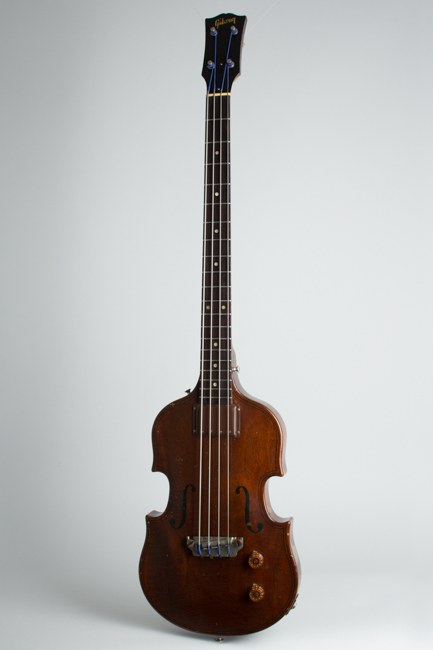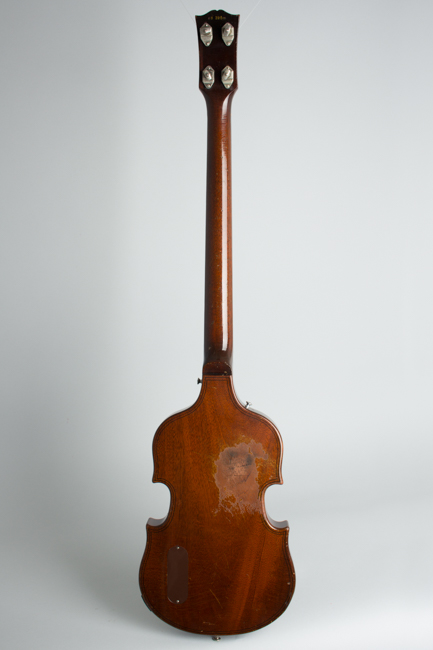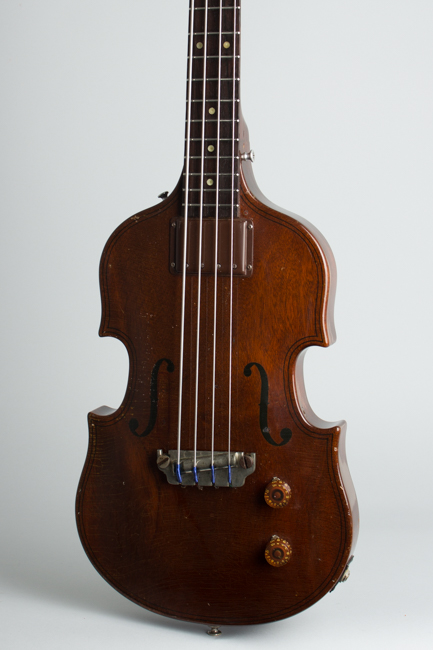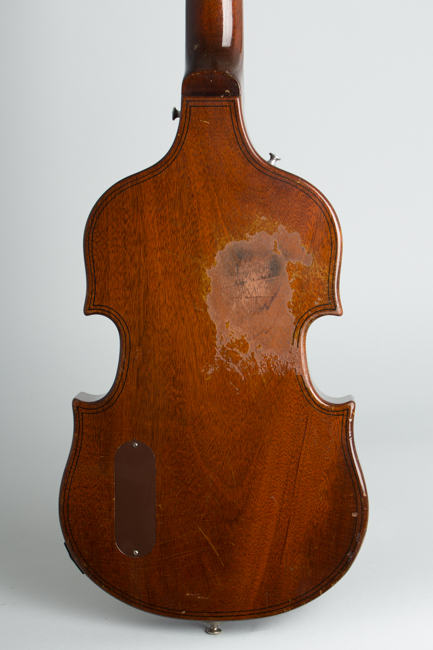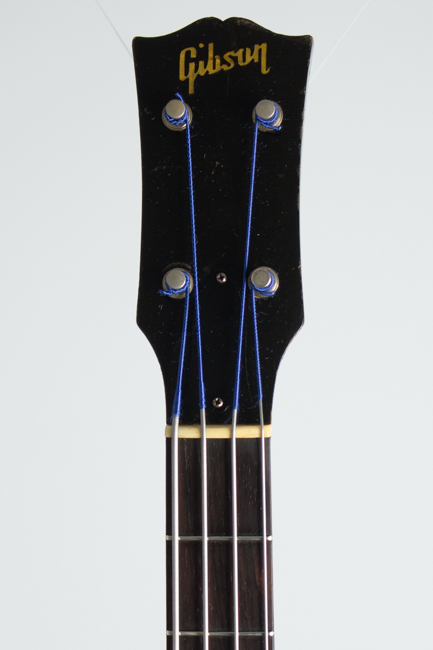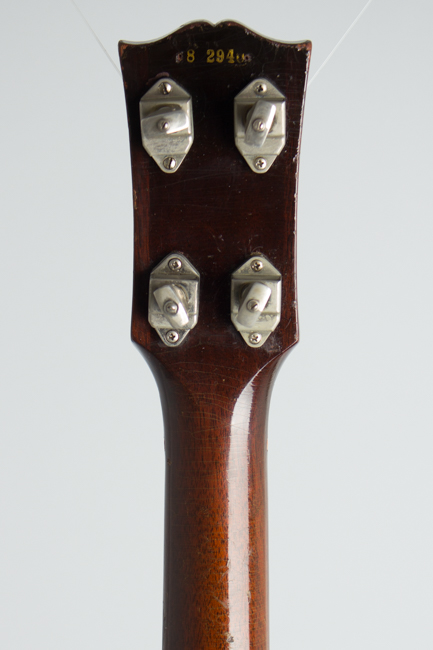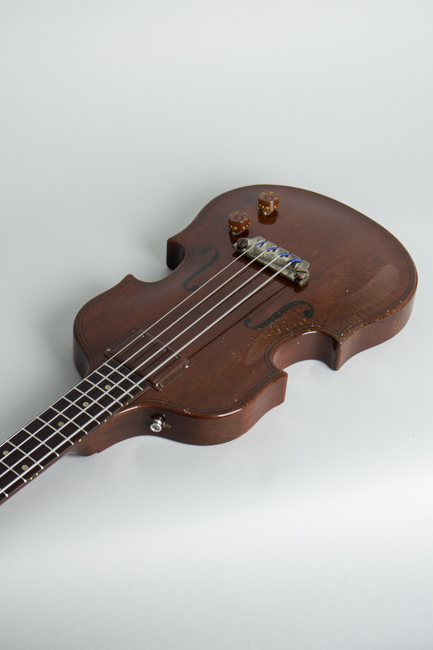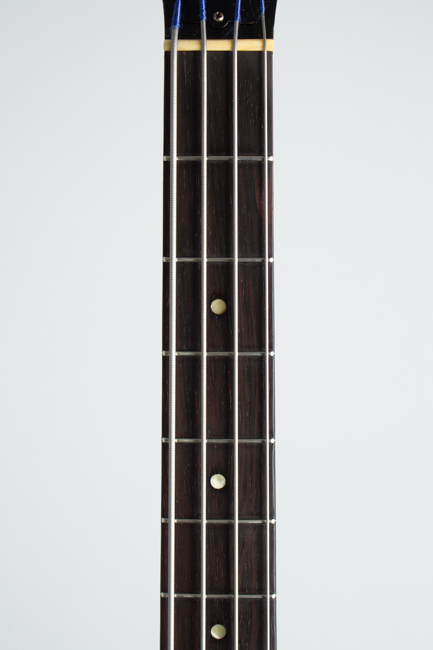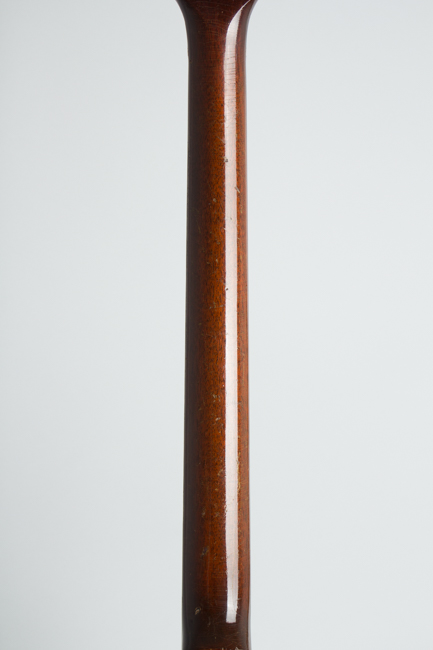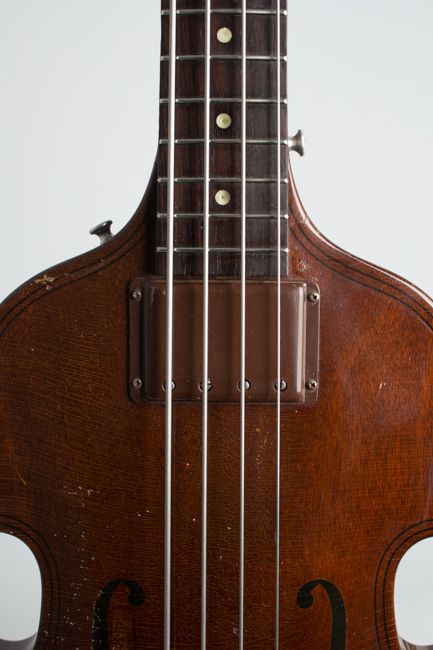Gibson EB-1 Solid Body Electric Bass Guitar (1958)
This item has been sold.
Item # 8652
Prices subject to change without notice.
Gibson EB-1 Model Solid Body Electric Bass Guitar (1958), made in Kalamazoo, Michigan, serial # 8-2940, dark mahogany lacquer finish, mahogany body and neck, rosewood fingerboard, black hard shell case.
We think this is just about the coolest and most distinctive electric bass ever designed -- and one of the most eccentric! The "Gibson Electric Bass" (the EB-1 name was not used until 1958, when the semi-hollow EB-2 debuted) was first issued in mid-1953 and is one of the very earliest solid-body basses. The "fiddle-shaped" body design is unique and owes nothing but general concept to the slightly earlier (late 1951) Fender Precision -- and was likely a subsequent inspiration to Hofner in Germany. Gibson president Ted McCarty wanted something that was as different from the Fender Bass as possible, and that's what the company delivered.
When introduced, the violin-body EBs were heralded as "a revelation in rhythm" by Gibson's sales department. This particular bass has a serial number dating to early 1958, marking it one of the last ever made. The EB sold all of 45 units that final year and the model had been produced in fairly small numbers since 1953. In 1959 they were replaced by the simpler slab-bodied EB-0. Gibson's sales records indicate a total of 546 sold over the entire decade.
This later 1950s EB-1 has the dark sonic character of all the early 30" scale thumpers from Kalamazoo. The large brown Royalite-covered pickup is actually a single coil unit; the huge coil is mounted on its side, which is why the polepieces sit at the bottom end. While still very powerful and deep-sounding, this particular pickup rig sounds pretty much indistinguishable from the 1959 and later humbucking versions.
The sculpted solid mahogany body has painted-on f-holes and "purfling" like a violin-family instrument, and originally a large (and seemingly superfluous) brown Royalite pickguard that is missing on this example. Even the knobs and jackplate were tinted brown. The tuners at the top of the 30 1/2" scale mahogany neck are Kluson banjo units -- an odd choice Gibson persisted with up through 1960. Usually these pegs mount keystone plastic buttons; this set has the metal buttons of the same shape used more commonly in the 1960s, but do not appear to have been replaced. These may be simply an earlier use of these less breakage prone pieces or may be a later substitution; at this late date it's impossible to tell for sure.
The Gibson Electric Bass has remained a connoisseur's oddity since its introduction. Although seen during the 1950s in the hands of the Flamingos, jump blues bandleader Lloyd Lambert, and most visibly Little Richard's Upsetters, the instrument never caught on in a big way. In later years Felix Pappalardi, Jack Bruce, Doug Lubhan, and even (on occasion) John Paul Jones have made use of the Gibson EB, and it remains one of the company's most distinctive creations -- even if seeming a bit whimsical in retrospect. This later model is a fairly well-worn but good-playing example, with the essential thump intact.
Overall length is 44 1/4 in. (112.4 cm.), 11 1/4 in. (28.6 cm.) wide at lower bout, and 1 3/4 in. (4.4 cm.) deep. Scale length is 30 1/2 in. (775 mm.). Width of nut is 1 11/16 in. (43 mm.).
This veteran bass looks to have had a long active career and so has some general wear overall but remains largely original and in fine playing condition. As noted the pickguard is long gone, but the rest of the original hardware is intact. There is finish wear in the form of dings, dents, and scrapes to the top, neck, and most heavily the back, which shows a fairly large buckle-wear spot into the wood. The always broken original brown plastic jackplate was replaced long ago, and there is a second strap button added on the underside of the neck heel. The top strap button remains in place; there is a mark just above it where it looks like a re-location was attempted and abandoned.
There are a couple of small filled screw holes in the top above the low E where a Fender thumbrest was added and later removed. This bass has just been refretted and is an excellent player, albeit with the very dark sound typical of Gibson 4-strings. It is not the cleanest 1950s Gibson has but is a nice solid-playing example with its original character intact. Includes a modern well-fitted rectangular Epiphone HSC. Very Good + Condition.
We think this is just about the coolest and most distinctive electric bass ever designed -- and one of the most eccentric! The "Gibson Electric Bass" (the EB-1 name was not used until 1958, when the semi-hollow EB-2 debuted) was first issued in mid-1953 and is one of the very earliest solid-body basses. The "fiddle-shaped" body design is unique and owes nothing but general concept to the slightly earlier (late 1951) Fender Precision -- and was likely a subsequent inspiration to Hofner in Germany. Gibson president Ted McCarty wanted something that was as different from the Fender Bass as possible, and that's what the company delivered.
When introduced, the violin-body EBs were heralded as "a revelation in rhythm" by Gibson's sales department. This particular bass has a serial number dating to early 1958, marking it one of the last ever made. The EB sold all of 45 units that final year and the model had been produced in fairly small numbers since 1953. In 1959 they were replaced by the simpler slab-bodied EB-0. Gibson's sales records indicate a total of 546 sold over the entire decade.
This later 1950s EB-1 has the dark sonic character of all the early 30" scale thumpers from Kalamazoo. The large brown Royalite-covered pickup is actually a single coil unit; the huge coil is mounted on its side, which is why the polepieces sit at the bottom end. While still very powerful and deep-sounding, this particular pickup rig sounds pretty much indistinguishable from the 1959 and later humbucking versions.
The sculpted solid mahogany body has painted-on f-holes and "purfling" like a violin-family instrument, and originally a large (and seemingly superfluous) brown Royalite pickguard that is missing on this example. Even the knobs and jackplate were tinted brown. The tuners at the top of the 30 1/2" scale mahogany neck are Kluson banjo units -- an odd choice Gibson persisted with up through 1960. Usually these pegs mount keystone plastic buttons; this set has the metal buttons of the same shape used more commonly in the 1960s, but do not appear to have been replaced. These may be simply an earlier use of these less breakage prone pieces or may be a later substitution; at this late date it's impossible to tell for sure.
The Gibson Electric Bass has remained a connoisseur's oddity since its introduction. Although seen during the 1950s in the hands of the Flamingos, jump blues bandleader Lloyd Lambert, and most visibly Little Richard's Upsetters, the instrument never caught on in a big way. In later years Felix Pappalardi, Jack Bruce, Doug Lubhan, and even (on occasion) John Paul Jones have made use of the Gibson EB, and it remains one of the company's most distinctive creations -- even if seeming a bit whimsical in retrospect. This later model is a fairly well-worn but good-playing example, with the essential thump intact.
Overall length is 44 1/4 in. (112.4 cm.), 11 1/4 in. (28.6 cm.) wide at lower bout, and 1 3/4 in. (4.4 cm.) deep. Scale length is 30 1/2 in. (775 mm.). Width of nut is 1 11/16 in. (43 mm.).
This veteran bass looks to have had a long active career and so has some general wear overall but remains largely original and in fine playing condition. As noted the pickguard is long gone, but the rest of the original hardware is intact. There is finish wear in the form of dings, dents, and scrapes to the top, neck, and most heavily the back, which shows a fairly large buckle-wear spot into the wood. The always broken original brown plastic jackplate was replaced long ago, and there is a second strap button added on the underside of the neck heel. The top strap button remains in place; there is a mark just above it where it looks like a re-location was attempted and abandoned.
There are a couple of small filled screw holes in the top above the low E where a Fender thumbrest was added and later removed. This bass has just been refretted and is an excellent player, albeit with the very dark sound typical of Gibson 4-strings. It is not the cleanest 1950s Gibson has but is a nice solid-playing example with its original character intact. Includes a modern well-fitted rectangular Epiphone HSC. Very Good + Condition.
